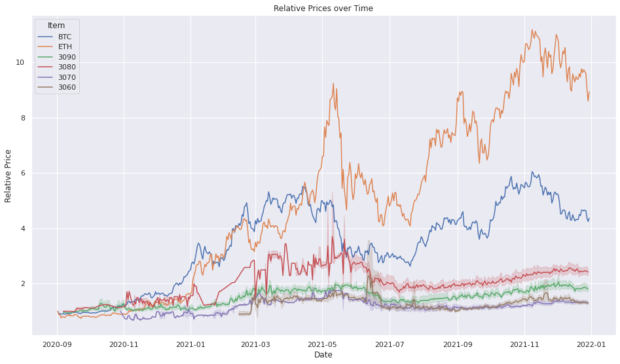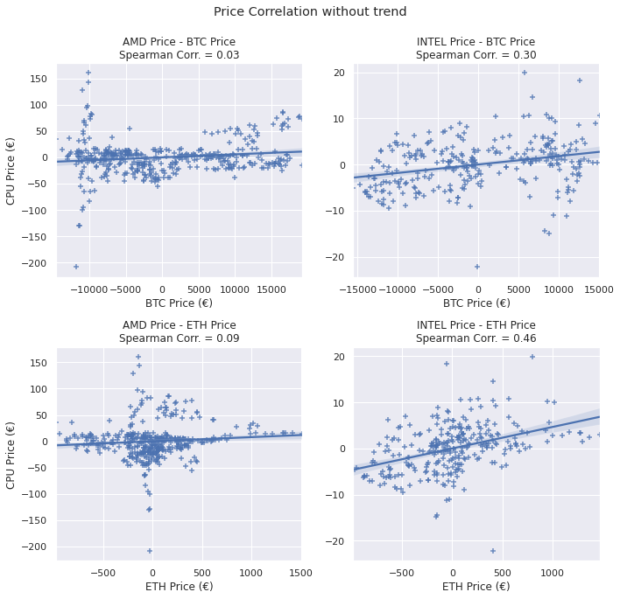Are Crypto Currencies to Blame for High GPU Prices?
Lately I'm paying more attention to the crypto currency and "DeFi" spaces, again. One discussion that comes up regularly: are miners to blame for the high GPU prices? To add some facts to this discussion, I’ve done a small analysis of GPU and crypto currency prices to determine if they are related.
Data Sources
GPU Prices
For GPU prices I used the german website https://geizhals.de. The website shows the prices of items over a time frame of six months. The data of the plots is delivered as JSON and can be easily scraped. I scraped the pricing data for the four current-gen NVIDIA graphics cards (RTX 3060 - 3090). As multiple manufacturers sell the same graphics card chips, I averaged the prices per chip.
Crypto Currency Prices
I used Yahoo! Finance as my source for the crypto currency prices. You can download the historic data as CSV.
Evaluation
For a first impression, I’ve added the bitcoin price to the plot of GPU prices. To normalize the prices, I divided each time series value by the first price observed. Squinting at this plot, you can already see that the overall trend in prices roughly line up.
For a more accurate analysis, I looked at the correlation factors and created corresponding scatter plots. Each dot in the plots represents one day. The Y-axis shows the price of the GPU at that day and the X-axis the price of the crypto currency. If prices correlated perfectly, all dots would lie on a diagonal line.
For the RTX 3060, there is only a weak correlation between prices. The correlation between RTX 3060 and ETH prices is not significant and has to be discarded. Keep in mind that the 3060 was just released on 26 of February, so we have less pricing data compared to the other GPUs. For the other cards, we see higher correlation factors. Whenever the price of one rose, the other rose too. The effect is strongest for the RTX 3090 and is visible in Bitcoin and Ethereum.
This analysis still has a flaw, as it does not correct for the overall trend in the price development. Prices change over time because of factors affecting all products. For example, inflation will rise all prices over longer observations. This creates a false correlation if you compare prices over a long time frame. To correct for this, the overall trend has to be removed from the data. I used a linear regression to remove the trend.
With the trend removed, the measured correlation between the prices is weaker, as expected, as we removed a linear factor from the data. The data still shows a correlation between crypto currency and GPU prices. The correlation is stronger for Bitcoin than for Ethereum.
To test the validity of these correlations, I did the same analysis for CPU from AMD and Intel. I used the prices of the generations; Ryzen 5000 and i-11000. The AMD prices show no correlation with the crypto currency prices (p-value below 0.05). For Intel chips, we can observe a slight correlation. This gives me more confidence that the correlation is real for GPUs.
Conclusion
We can see a correlation between GPU prices and the value of crypto currencies, but correlation does not mean causation. A causation is plausible in this case. Miners earn a lot of money with their businesses and can predict how much they will earn on average with each graphics card. As long as their earnings are high enough, it is profitable for miners to buy cards at higher prices. Bitcoin miners rarely use GPUs anymore, but ASICs. The production of ASICs may add more price pressure on silicon and chip production. I don't have any data on the amount of production capacity being used by ASICs, so I don't know how much pressure they produce.
Why is this a problem? There is nothing inherent to blockchains that demands such a high dependence on computing hardware. The resources spent by miners only serves as a mechanism to increase the cost of changing data in the blockchain. This cost serves as a mechanism to secure blockchain. Other mechanism for securing blockchains exist and successfully used (see Proof of Stake). Proof of Work creates external costs (environmental impact, higher electricity prices, GPU scarcity) to benefit a small group of miners.





